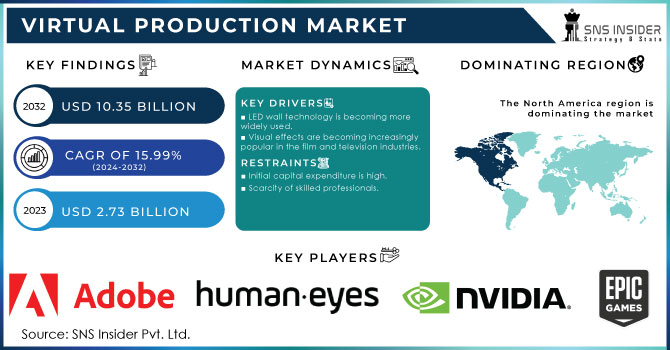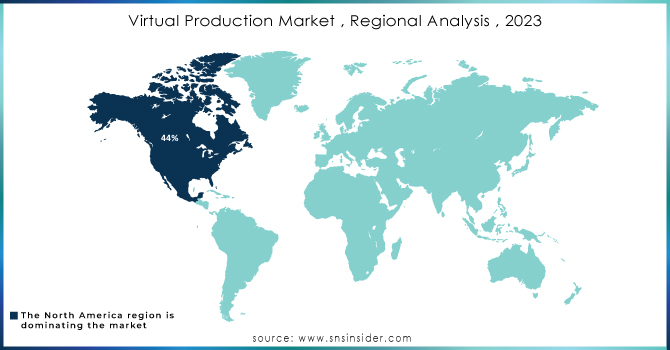Virtual Production Market Size & Trends:
The Virtual Production Market Size was valued at USD 3.19 Billion in 2024 and is expected to reach USD 10.35 Billion by 2032, at 15.99% CAGR During 2025-2032. The virtual production market is a cutting-edge and quickly developing sector of the entertainment business, changing the way movies, TV shows, and live events are produced. The rise of virtual reality (VR), augmented reality (AR), and mixed reality (MR) has boosted virtual production as a transformative answer, improving creativity and productivity in content development. There has been substantial growth in the U.S. in the fields of content creation for virtual reality (VR), augmented reality (AR), and mixed reality (MR). Approximately 70.8 million individuals in the United States engaged with VR every month in 2023, marking a 6% rise from the year before. The prediction is that this figure will surpass 75.4 million by the year 2025. Content creation is playing a crucial role in driving this growth, as VR and AR are being more widely used across different industries such as gaming, healthcare, and education. AR and VR are increasingly necessary tools in immersive storytelling, particularly in advertising and marketing within the content creation field.

Get more information on Virtual Production Market - Request Sample Report
Key Virtual Production Market Trends:
-
Growing adoption of real-time rendering engines like Unreal Engine and Unity to enhance visualization and speed up decision-making in filmmaking.
-
Increasing use of LED volume technology to replace traditional green screens, delivering realistic lighting and immersive backgrounds.
-
Integration of artificial intelligence and machine learning for advanced visual effects, automation, and data-driven pre-visualization.
-
Rising demand for remote collaboration tools in filmmaking, enabling global teams to work together seamlessly on virtual production projects.
-
Expansion of hybrid work environments in film studios, promoting inclusivity and enhancing collaboration between on-screen and off-screen professionals
Virtual Production Market Growth Drivers:
-
Rapid technological advancements driving growth in the virtual production market.
One of the key drivers for the Virtual Production Market is the fast-paced technology advancements. High-quality graphics engines, real-time rendering, and several augmented reality and virtual reality solutions have made it easier for filmmakers to implement virtual production. The real-time engines, such as Unreal Engine and Unity, have made visualization of the scenes significantly more accessible for filmmakers. Instead of imagining how a particular aspect of the film will look, they can see their creative vision materialize in front of their eyes or on the display. It provides them with instant feedback and allows to make changes instantly, so the decision on how to proceed next in the process of shooting can be made very quickly by the director, cinematographer, and the production crew. Previously, the green screen method was being used but often provided poor lighting and was unrealistic. Lastly, artificial intelligence and machine learning integrated with virtual production also allow more advanced visual effects, automation of otherwise repetitive procedures, and more advanced data analysis.
-
Virtual production revolutionizes filmmaking with remote collaboration and inclusivity.
The global pandemic has changed the course of filmmaking, and now, the fields are in drastic need of remote collaboration and hybrid work environments. Of course, different types of tools may help to resolve the issue, virtual production being the foremost solution. It is instrumental in that it makes it possible to bring together professionals from all over the world despite the physical separation. These tools allow filmmakers to link up virtually and share their assets to recognize the complete project. This may open up the possibility for hiring specialists from multiple countries to work on a single product. At the same time, the approach promotes inclusivity because now all people with various backgrounds can contribute to the project.
Virtual Production Market Restraints:
-
The challenges of adopting virtual production in filmmaking and production industries.
Virtual production is a very advantageous process, but there is a high learning curve that comes with it. Filmmakers and production teams need to acquire significant training in the technology and tools to apply any virtual production technique. It is time-consuming and might require significant financial resources. Yet another reason negatively influencing virtual production is the absence of a sufficient explosion of a talent pool. An increasing number of filmmakers and production companies are interested in hiring skilled professionals to facilitate the use of virtual production techniques. There are often no skilled and experienced workers that can successfully apply the technology and control all the nuances of these tools. This lack of proficient employees in the field of virtual production might deprive studios of a valuable opportunity to use virtual production in their work because they need targeted personnel.
Virtual Production Market Segment Analysis:
By Type
The post-production segment led the market in 2024 with a 45% market share because of its vital role in improving visual storytelling. Post-production includes editing, special effects, color correction, and sound design, where filmmakers perfect and improve the recorded footage to produce a final polished product. The increase in top-notch streaming platforms and the desire for visually attractive content have strengthened the necessity for strong post-production services. Adobe and Avid are essential players in the industry, offering high-end tools for editors and VFX artists, such as the Creative Cloud suite and Media Composer software.
The production segment is accounted to experience a rapid CAGR during 2025-2032, mainly driven by advancements in real-time rendering technologies and virtual set usage. This part incorporates advanced technologies such as LED walls, motion capture, and virtual reality, enabling filmmakers to develop immersive environments that elevate storytelling. Leading the charge in this revolution are companies like Epic Games, utilizing its Unreal Engine, and NVIDIA, taking advantage of its graphics processing abilities.
By Offering
The software segment held a major market share of 42% because of its crucial part in developing engaging and hands-on experiences. Software solutions empower filmmakers and content creators to manipulate digital assets, enhance visual effects, and optimize production processes. Software End Users play a crucial role in providing top-notch content by utilizing cutting-edge tools like real-time rendering, motion capture, and virtual reality integration. Major companies such as Epic Games with Unreal Engine and Autodesk with Maya and 3ds Max software serve a range of industry sectors, including film, television, gaming, and advertising.
The hardware segment is to become the fastest-growing segment during 2025-2032 due to advancements in technology and growing demand for high-quality production capabilities are fueling the rapid expansion in the Virtual Production Market. Advancements in camera technology, LED displays, and motion-tracking gadgets heighten the authenticity of virtual worlds and boost productivity in filmmaking. NVIDIA and Mo-Sys both offer key technologies in their respective fields: NVIDIA with high-performance GPUs essential for real-time rendering, and Mo-Sys with camera tracking solutions for smooth integration of physical and digital elements.
Virtual Production Market Regional Analysis:
North America Virtual Production Market Insights
North America dominated the virtual production market in 2024 with a 38% market share. The region benefits from advanced technology infrastructure, significant investments in film and media production, and a concentration of leading companies like Netflix, Amazon Studios, and Disney. These companies leverage virtual production techniques to create immersive experiences and streamline production processes. The introduction of technologies such as LED walls and real-time rendering has transformed traditional filmmaking, allowing for greater creative flexibility and cost efficiency.
Asia Pacific Virtual Production Market Insights
The Asia-Pacific region is rapidly emerging as the fastest-growing region during 2025-2032, driven by increasing investments in the entertainment industry and advancements in digital technology. Countries like China, Japan, and South Korea are at the forefront, with a growing demand for high-quality content fueled by expanding streaming platforms such as Tencent Video and iQIYI. The region's strong focus on technological innovation and the rising popularity of virtual reality (VR) and augmented reality (AR) End Users in filmmaking contribute to its growth.
Europe Virtual Production Market Insights
The Europe virtual production market is growing steadily, driven by strong demand from film, television, and commercial sectors. Advancements in real-time rendering, LED wall adoption, and AI-powered visual effects are boosting regional adoption. Countries like the U.K., Germany, and France lead with robust media industries, government support, and high investments in digital filmmaking infrastructure, making Europe a key hub for innovation in virtual production technologies.
Latin America (LATAM) and Middle East & Africa (MEA) Virtual Production Market Insights
The LATAM and MEA virtual production market is witnessing gradual growth, fueled by expanding film industries, increasing adoption of AR/VR tools, and infrastructure modernization. Countries like Brazil, Mexico, the UAE, and South Africa are emerging as key markets with growing creative industries. However, challenges such as limited budgets and access to advanced technology slow widespread adoption, though international collaborations and government initiatives are creating new opportunities for regional market development.

Need any customization research on Virtual Production Market - Enquiry Now
Virtual Production Companies are:
-
Adobe
-
Epic Games
-
NVIDIA Corporation
-
Technicolor
-
Autodesk
-
HTC Corporation
-
Pixar
-
Foundry
-
Blackmagic Design
-
Weta Digital
-
Unity Technologies
-
Samsung
-
Blender
-
Blaize
-
Microsoft
-
Intel Corporation
-
Rohde & Schwarz
Competitive Landscape for Virtual Production Market:
Samsung plays a vital role in the virtual production market through its advanced display technologies, particularly high-definition LED walls and immersive visual solutions. Its Samsung Odyssey VR headsets and professional display systems enhance real-time rendering, realistic backgrounds, and immersive experiences for filmmakers. By supporting seamless integration with engines like Unreal and Unity, Samsung strengthens virtual sets, remote collaboration, and visualization, making it a key enabler of innovation in virtual production environments.
-
May 2024: Samsung introduced "The Wall for Virtual Production," a cutting-edge LED display that enhances immersion for actors and reduces production costs by allowing real-time video display behind live actors.
Sony is a key player in the virtual production market, leveraging its expertise in professional cameras, crystal LED display technology, and imaging solutions. Its high-resolution digital cinema cameras, such as the VENICE series, are widely used in virtual sets for precise image capture and cinematic quality. Sony’s Crystal LED walls provide realistic, immersive backgrounds that replace traditional green screens, while its innovations in broadcasting, imaging, and content creation strengthen its role in advancing virtual production.
-
March 2024: Sony launched a new LED Virtual Production Stage, enhancing capabilities for filmmakers by integrating high-resolution LED panels that enable dynamic background changes in real time.
| Report Attributes | Details |
|---|---|
| Market Size in 2024 | USD 3.19 Billion |
| Market Size by 2032 | USD 10.35 Billion |
| CAGR | CAGR of 15.99% From 2025 to 2032 |
| Base Year | 2024 |
| Forecast Period | 2025-2032 |
| Historical Data | 2021-2023 |
| Report Scope & Coverage | Market Size, Segments Analysis, Competitive Landscape, Regional Analysis, DROC & SWOT Analysis, Forecast Outlook |
| Key Segments | • By Type (Production, Pre-Production, Post-Production) • By Offerings (Hardware, Software, Services) • By End-User (Movies, TV Series, Online Videos, Commercial Ads, Others) |
| Regional Analysis/Coverage | North America (US, Canada, Mexico), Europe (Germany, France, UK, Italy, Spain, Poland, Turkey, Rest of Europe), Asia Pacific (China, India, Japan, South Korea, Singapore, Australia, Taiwan, Rest of Asia Pacific), Middle East & Africa (UAE, Saudi Arabia, Qatar, South Africa, Rest of Middle East & Africa), Latin America (Brazil, Argentina, Rest of Latin America) |
| Company Profiles | Adobe, Epic Games, HumanEyes Technologies, NVIDIA Corporation, Technicolor, Autodesk, HTC Corporation, Mo-Sys Engineering, Pixar, Vicon Motion Systems, Foundry, Blackmagic Design, Weta Digital, Unity Technologies, Samsung, Blender Foundation, Blaize, Microsoft, Intel Corporation, Rohde & Schwarz. |

